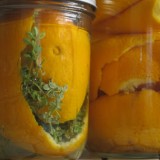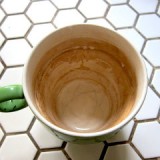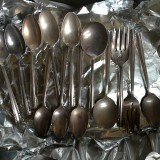We talk about non-toxic housecleaning in almost every lecture we do, and we cover it in both books, but I can’t remember if we’ve talked about cleaning the bathroom on this blog. We did cover how to clean kitchen sink fairly recently, but I’m not sure what else we’ve done. Of course, I know my regular Root Simple readers are so hardcore they could give me tips in this area, but I thought it would be good to cover non-toxic cleaning for new readers and folks crawling the interwebs for information.
It’s a really, really important topic. There’s no simpler way to remove toxins from your immediate environment than switching out your cleaning supplies. We call this “low hanging fruit.” There’s lots of things in this world that you may not like, but which you can’t control. Housecleaning, however, is totally within your power to change. Cleaning this way also saves you money and cabinet space, reduces plastic waste and not least of all, protects our waters from chemical contamination.
Just say no to chemical warfare in your home.
It all starts with the Holy Trinity of Non Toxic Household Cleaning:
- White vinegar*
- Baking soda (sodium carbonate)
- Liquid castile soap, such as Dr. Bronner’s
Get yourself these things, some empty spray bottles and rags, and you’re in business. You don’t need anything else.
Prep:
Fill one spray bottle halfway full of white vinegar. Fill it the rest of the way with water. This is your all purpose wipe down spray, aka the 50/50 spray
Take another empty spray bottle and pour about a tablespoon of liquid soap into the bottom. Fill it up with water. This is called “soapy water.”
Yep. This is why we make the big bucks.
That’s it. You’ll find other recipes which are more involved. Some people like to put a squirt of soap in their vinegar water. Sure, why not? Other people make rather elaborate concoctions of a little of this and a little of that. I’ve found that simple is best, because 1) I can’t be bothered to do more and 2) I’m not sure any more elaboration is necessary.
Cleaning ain’t rocket science, and it’s not like I’m prepping my bathroom for surgery. Stuff just needs to be wiped down to remove dust and other surface dirt. Whatever I clean, however I clean it, will get dirty the next time it’s used, so why all the struggle and germ phobia?
 |
| All cheap white vinegar is the same, but I like El Pato brand because of the duck on the label. Why doesn’t El Pato make t-shirts? |
The vinegar spray is great because it doesn’t leave any residue behind (which soap does), shines up things fairly well, disinfects to some extent because it is an acid, and deodorizes as well. Yes, it smells like vinegar, but you get used to that. You begin to associate that smell with the idea of clean. The scent goes away when it dries, and it takes any lingering odors with it.
The bathroom sink
 |
| Work the right side, the left side is yet to be done. See the hard water deposits forming around the base of the faucet? That’s on its way out. |
The bathroom sink doesn’t get nearly as dirty as the kitchen sink, at least not in our house. See my post on the kitchen sink* if you have a really grotty sink that needs bleaching. In the bathroom, all I do is spray down the sink with the vinegar/water spray. Generously. Regular use of it will help prevent hard water deposits from forming around the faucets. Spray and wipe. I find using a clean, dry rag gives the best polish to the sink.
If you already have hard water deposits around your faucets or elsewhere, apply full strength vinegar to that area. If it runs off (depends on how your sink is shaped) try soaking rags or paper towels with vinegar and lay those over the deposits. Let the vinegar work its magic for a half hour or so and come back. You should be able to scrub off the deposits now. If you still have trouble, trying applying the vinegar hot.
To clean scummy build-up out of the sink, follow your vinegar wipe-down with a generous sprinkle of baking soda. Scrub with a damp cloth or a nylon sponge. Rinse.
Bathtub/Shower
 |
| The advancing line of clean |
Here I prefer to use soapy water spray instead of the vinegar spray, though you could try the vinegar. I find that soapy water cuts through soap-scum build up quite well, perhaps because like dissolves like?
To clean our clawfoot tub, what I always do first is spray the whole interior with soapy water, then sprinkle over that a generous coating of baking soda, focusing on the spots that look grungy. I scrub these areas first, using an old nylon net bath puff, which is my favorite tub cleaning tool. A nylon sponge or a rag would work fine, too, though. The secret here is to use not so much soapy water–just enough to wet the surface, not enough to puddle. The baking soda should be just damp when you’re scrubbing with it. If it’s too wet, it’s not effective.
After I scrub the scummy parts, I wipe down the whole tub and rinse.
Note: I have no proof, but I do believe that big brand soaps (and their knockoffs) make more soap scum than natural soaps, and that scum is harder to remove than what’s left behind by natural soaps. They are definitely not good for your skin. When you switch your cleaning products over, switch over your bar soap to a nice, natural soap. Maybe something from the farmers’ market, or maybe even something you make yourself. Or yes, the ubiquitous Dr. Bronner’s is fine, too.
Toilet
 |
| Plunging the bowl to reduce water level. Cat heads are not recommended for plunging, as they are not bristly enough. |
First thing I do is start scrubbing the bowl with the toilet brush, just using the bowl water. It’s amazing how much plain water and a scrub brush can do. I plunge as I scrub, with the goal of lowering the level of the water in the bowl down to a minimum. If you can’t make this happen by scrubbing & plunging, then pour a bucket of water in the bowl–that will lower the water level, too.
That first scrub takes care of a lot of the basic build up. Next, soak the bottom of the bowl in straight vinegar to remove stains and the-lord-knows-what that collects down there. Take that big cheap gallon jug of vinegar and refill the bowl to the usual water line with a couple of cups of vinegar. I like to pour the vinegar all around the sides of bowl to give those surfaces a good antiseptic dousing. Then let the vinegar sit at the bottom of the bowl for about a half hour. When you come back, give a final swish and flush.
While the vinegar is doing its work in the bowl, spray the entire toilet from top to bottom–back, lid, seat, base– with the 50/50 vinegar water, and then wipe it down with a rag. This is plenty sufficient to clean those parts, and if you have a seat/lid that shows water spots (like ours, because it’s black) just be sure to wipe those parts dry and you’ll have no spots.
If you have rust stains under the rim, pure vinegar (how did you guess I’d say that?) will help. Soak paper towels or rags in vinegar and plaster them under the rim and leave them as long as you can. When you come back, you should be able to scrub those stains away. Lemon juice would also work well.
 |
| Vinegar soaked rags under the rim, working on the rust stains. Apologies for the terrible picture! |
Mirror
Because I’m way too lazy to make up a different formula or even pick up a different spray bottle, I use the 50/50 vinegar spray on the bathroom mirror. Spray on, buff off with a dry cloth. Works fine. Same goes for our mystery metal Ikea garbage can.
(Amendment as per Donna’s comment below: I should say that you can clean your mirrors with water alone. Donna also recommends newspaper for polishing, which is a fine technique. All in all, you just need to get windows or mirrors slightly wet, then polish them with whatever you have on hand that is clean and dry. I use the vinegar spray because it is a handy moisture delivery device.)
Floor
Again, all you need is vinegar–about a half cup in a bucket of hot water, or more like a full cup for a big bucket or a dirtier job. Mop. No rinsing required. I use this on tile, linoleum, vinyl flooring and even, with a barely damp mop, wood floors.
If I’m in an expansive mood I’ll add a few drops of essential oil to the bucket so I can Sniff n’ Mop.
* Warning Regarding Vinegar: Vinegar is apparently not recommended for use on stone surfaces–like granite counter tops or stone composite floors. I don’t have any personal experience with these surfaces, but I’ve read that this is so. Vinegar is a mild acid (5%), and acid can etch stone. It’s hard to imagine vinegar etching stone, especially when diluted, but it’s best to be cautious. The effects might build up over time. As always, ask the manufacturer of the stone surface, if you can.
Also, if you leave full strength vinegar on a finished metal surface for long enough, you might end up dulling it. I’ve never had a problem wiping down my fixtures and appliances with 50/50 blend, but once I soaked a sink head in a bag of hot vinegar overnight. My goal was to remove mineral deposits in the faucet. It worked, but it also dulled the head of the faucet. You can always rinse your faucets off after cleaning with vinegar, just to be sure. Rinse with water and then dry with a cloth and you’ll have no spots. Until someone uses the sink.
* I just realized that I posted that “how to clean your sink” post exactly one year ago to the day. Something about Feb. 13th makes me think about cleaning, apparently. Must be my romantic nature.
 |
| Phoebe, the implacable bathroom supervisor, says “Scrub, you lazy swab! Damn your eyes!” |








Does vinegar sanitize surfaces?
This was a great post, thank youI I switched over all my cleaning products 3 years ago when I bought your book. I haven’t looked back since. I’ve even converted many friends and readers of my blog to baking soda and vinegar.
You probably know this already, but since you didn’t mention it in your post, crumpled newspaper is the best for cleaning glass surfaces: windows, mirrors, etc. In the bathroom, I spritz the newspaper wad with a touch of plain water and rub down my mirror. Works perfectly well. I had read somewhere that no actual cleaning solution is necessary for mirrors, just water and some rubbing, and I have found that this is true. The key is not to soak the paper or you’ll just be pushing water around. A touch is all you need.
+3000 points for the use of the Look What the Cat Dragged in album cover.
@Teresa: White vinegar is about 5% acid, and as such does disinfect. It’s not in the same league as bleach, but I believe it’s quite enough for normal household cleaning.
@KC: Excellent!
@Donna: Right! Newspapers are tried and true. That’s how my grandma did her windows. We don’t take the paper, so don’t have papers on hand, so I forgot about that one. Definitely true about the water alone, too–you may have read that in our first book. I did tests and found that water worked as well as windex on the dog snot on our door.
I guess the lesson is glass just doesn’t want to hold dirt and it doesn’t take much but a little friction and moisture to get the dirt off. It’s just convenient for me to squirt with the 50/50 mix while I’m working as to use anything else.
When we installed tile flooring in our kitchen, the handyman told us to use absolutely nothing but white vinegar and water to clean it. Works beautifully.
On feline scrub brushes: A favorite expression at our house for a frustratingly difficult task is “It’s like trying to put a cat down a toilet.” Indeed.
I love vinegar!! But it isn’t that great at disinfecting. Since I don’t want a hyper sterile house, I think that’s a good thing. I agree-good for normal household cleaning.
Vinegar does kill many germs, especially if left on the surface for 10 minutes (most people don’t read the labels, but Lysol says 10 min too) but I don’t trust it for the toilet or counters that have had raw meat on them. I decided to get a steam cleaner for actual disinfecting. It’s more expensive, but since harsh smells give me headaches, it’s worth the money for me.
Excellent post. I am sending it to all my friends. I too wondered if the vinegar disinfected and am glad to hear that it does. Wasn’t there something about people using it during the Black Plague to disinfect the coins passed to them? I always wondered if that was true or superstition.
I am also wondering if vinegar is OK for septic systems? I just moved and am on septic…a new experience for me.
I’ve lived in septic tank-supplied homes since I was a small child. Vinegar is fine. It’s much worse to put heavy-duty disinfectants down your drains, because that will kill off the good bacteria that breaks down your septic tank contents.
I’ll try to be delicate here, but watch what you put into your septic. It will all have to be pumped out at your expense and the faster you fill it up, the more often you have to call the friendly septic tank guy. Absolutely no feminine products! I have a small trash bin next to the toilet for non-soiled toilet paper; the really dirty stuff goes into the toilet. I dump the bin into the outside garbage can every day so there’s no smell and no cats running through the house with wads of toilet paper. Which they would do in a heartbeat if I gave them the chance.
@Morningglory: As far as I understand, vinegar, baking soda and other less toxic/non-toxic materials are preferable to ordinary household cleansers in septic systems.
And yes, I’ve heard they infused vinegar with antiseptic herbs, like sage, and used it to ward off plague. Did it work? Dunno! The smell might have scared off the fleas! Look up the legend of the 4 Thieves vinegar.
About soaps. Modern bar soaps, especially deodorant soaps have WAX in them. This helps seal your pores and helps you “smell fresh all day long” If soapy water or vinegar is removing the soap scum then it either has very little wax or no wax, if you are struggling to remove build up or white stains then you are using a soap with wax.
I say this as I’ve been cleaning with vinegar and baking soda for a few years now and there is one problem shower – dark tile, white buildup. It took a long time to find the answer to this problem – switching soaps and then hard mechanical scrubbing and steam.
fyi – lots of people especially men are being sold this product.
I like to use rubbing alcohol in a spray bottle to clean. It is great for glass and windows and also it is a very good disinfectant. I think that would qualify as a natural cleaner, right?
Quite by accident but related to today’s post, I ran across this excellent video on how to make laundry soap today.
http://www.themorristribe.com/subscribe-to-the-tribe/
@Anon: I’m such a bad blogger. I’m not going to go look this up right now, but I remember reading something about how commercial soaps is more prone to forming hard scum because they contain tallow (and yes, if a soap doesn’t say it’s all veg, it’s going to have tallow in it). Something to do with sodium stearate, I believe–but don’t quote me on it. I’ve not heard of this wax thing you speak of.
@Sara A.: Yes, rubbing alcohol is very good for shiny surfaces. If the queen was coming to inspect our house I might rub down all our faucets with it for a nice shine. It’s more expensive than vinegar–so, for instance, I’d never use it by the cupful to clean the toilet! But, no, it’s not toxic to the skin. It would be bad to swallow, of course, so it needs to be kept away from little kids.
I just tried your bathtub-cleaning method today and it worked AMAZINGLY. Better than the Mr. Clean Magic Eraser that everyone raves about but that I found to be meh.
How do you clean moldy tile grout? 🙁 I am currently waging that war unsuccessfully.
Alcohol can be absorbed through the skin and given enough exposure can cause alcohol poisoning…talking about rubbing alcohol.
I saw a video of an MD who was saying that she kept a spray bottle of vinegar and another of hydrogen peroxide. She sprayed surfaces first with vinegar and cleaned and then with the H2O2. She stated that using one and then the other cleaned surfaces where meat was prepared and bathroom surfaces.
Another tool other than cat heads for the bathroom is old toothbrushes. I have one for tub and sink and baseboards and another for the commode. In the kitchen under the sink I keep half a dozen. When I transfer a toothbrush to the bathroom, it never returns to the kitchen. Using a toothbrush at the base of faucets does not scratch the faucet of sink.
My clawfoot tub shines after a baking soda scrubbing. Usually I cannot bend far enough and long enough to make it shine.
@Parsimony: Funny enough, I’m posting about the vinegar/hydrogen peroxide tomorrow.
@Emily: I’m no grout expert. We’ve been lucky enough to escape that particular household curse so far. If you’ve been waging war, I’m sure you’ve tried all the usual suspects. Have you tried oxyclean?
Of course the real solution to this problem is to get your grout sealed, so it doesn’t happen in the first place. If I were you, I’d resort to any means necessary to get it white (x-14?) and then seal it and keep it sealed with regular reapplications of sealant. Not the most groovy answer, I admit, but better than living with mold or re-doing your bath.
Also, I assume you mean the grout, not the caulking. Once caulking goes black I don’t think anything can help.
The main ingredient making Oxyclean allowing it to do its magic is sodium percarbonate. Mixed with water, it creates hydrogen peroxide and soda ash. I have a five pound bucket of it around for attacking certain clean up jobs.
Thanks for a great post. I’m always looking for ways to get green cleaning done.
BTW, I now have ‘Every Rose has it’s Thorns’ on my brain. Thanks!
Any recommendations for stainless steel appliances? I have been using water up till now but it leaves horrible streaks. I have been told that anything other than water will ruin the finish.
I’ve found that with Stainless Steel, glass, and mirrors the trick is in the cloth you use.
I use a small amount of water on just a regular rag (old tshirt or towel) to remove the gunk. Then I polish with a microfibre cloth (cheap at $ stores). The biggest thing with microfibres is how you clean the rag. Soaps and fabric softeners will leave residue. I soak mine in bleach and vinegar overnight, rinse WELL, then hang to dry.
@Anon: I don’t have personal experience with stainless steel finishes, and don’t want to rec. anything that might harm the finish. I’ll leave that to Good Housekeeping:
http://www.goodhousekeeping.com/home/heloise/how-to-clean-streaks-on-stainless-steel-refrigerator
Or maybe you should just use the stainless steel cleaner the manufacturers push. Any time you play with homemade formulas you run the risk of strange things happening. While I was writing Making It I tried to develop a homemade dishwasher detergent and ended up coating the whole dishwasher and all the dishes in this powdery white film! Thought I’d never get it off.
Great post, thanks. It was a really fun to read refresher.
I have found for soap scum in the bathtub that this works well. Spray the tub with straight vinegar. Sprinkle with baking soda, throw it against the sides of the tub and everything. Go find something to do for 30-45 minutes. Come back and scrub.
The scrubbing seems so much easier to me when I wait for the 30 minutes.
We started the kids (5 & 7) cleaning their own bathroom a few weekends ago. I would have been against it, except that I’d been reading about the cleaning power of vinegar, so I soaked a few towels in it and gave each of them one to wipe/scrub with. Their bathroom hadn’t looked as good as it did when they were done since we moved into the house. And it allowed my better half and me to concentrate on my cleaning responsibilities without worrying about them melting their eyeballs or killing themselves with bleach (thereby making them feel more trusted and showing them that we feel confident in their capability to accomplish tasks assigned to them). Perfect cleaning agent, IMHO.
Stupid question time: what is so bad about bleach?
Since i stopped using bar soap and just use liquid in the shower, i don’t get ANY scum. I only have to clean the shower every few months. Dr. Bonner’s rocks!
thanks
My wife and I were using White Vinegar to clean for years, but her corn allergy has gotten so bad that she can’t even get it on her skin anymore. We switched to Apple Cider Vinegar a few years ago and it seems to do about the same, although with a much stronger odor.
There was a period where I had my doubts, we had switched to an ACV solution when we moved into a new home and our tub didn’t seem to be coming clean. So we went out and bought some Ajax and discovered that our fiberglass tub just doesn’t want to get clean, no matter how much toxic chemical and elbow grease you apply. -So it was out with the Ajax, and back to the ACV. It may not look very clean, but it is, I promise. 😉
I was tired of my bathroom smelling like a salad, and yet I have OCD so I called the kohler co. And asked them what to use on the tub bottom as nothing was working.
The Customer service lady said call this 800 number and get this stuff called ROG3 , I spoke to a lady named Vanessa and she explained to me they only sell it on the website or through Amazon.com so I went ahead and ordered being skeptical I said let me give it a shot even though I thought it was kind of expensive, She assured me that I need to get the kit which comes with 2 quarts special scrubby pad special foaming spray head so I did and let me tell you it really works great
Great post. And thank you for not overstating the effectiveness of non-toxic substances like vinegar. Yes, it does disinfect to an extent, though it’s not as effective at doing this as so many people claim. At the end of the day, for domestic applications, the majority of the time, it’s a great cleaning product to have. Especially when fighting mineral build-up.
Remember – low PH substances (acidic) are great for mineral build-up; high PH (alkaline) cleaners are ideal for grease and organic build-up.
I would caution against using vinegar on anything with a finish and not thoroughly cleansing the area with water afterward. While vinegar’s acidity is good for removing soap scum and lime, it also has a tendency to ruin the finish on faucets and other fixtures.
I was very upset when I first learned this because vinegar was my go-to all-purpose cleaner. However, I learned that you can use two tablespoons of mild soap, like Castile, in a 32-ounce spray bottle. Just add water to the soap and you are ready to clean.
You know, it’s true that full strength vinegar can dull some finishes, so I’ve updated my vinegar warning above. I should have mentioned that to begin with. Thanks. However, I will say I’ve never had a problem using my 50/50 spray on my appliances and fixtures.
Soapy water does clean stuff very well–that’s why it’s one half my arsenal– but as one of the comments above says, vinegar excels at removing mineral build up, while soap works on grease and organic matter. So I like to have both on hand.